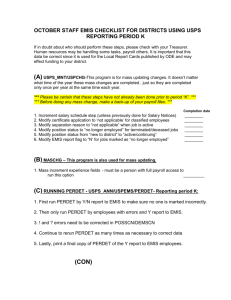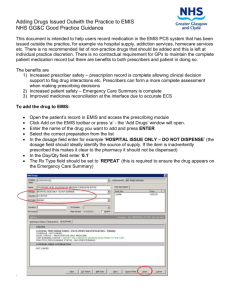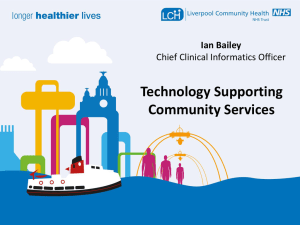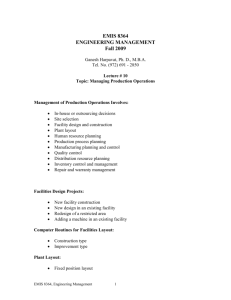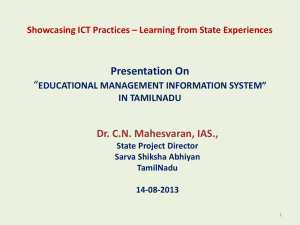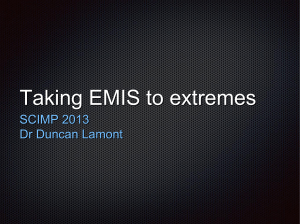CSE 6534 MANAGEMENT FOR ENGINEERS
advertisement
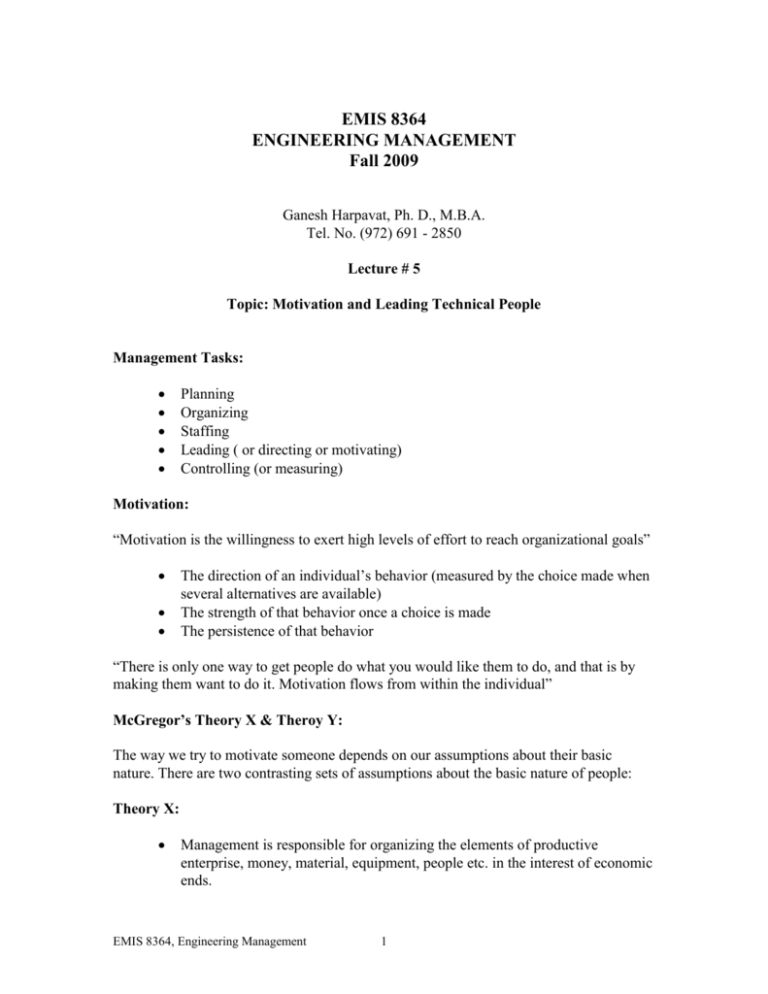
EMIS 8364 ENGINEERING MANAGEMENT Fall 2009 Ganesh Harpavat, Ph. D., M.B.A. Tel. No. (972) 691 - 2850 Lecture # 5 Topic: Motivation and Leading Technical People Management Tasks: Planning Organizing Staffing Leading ( or directing or motivating) Controlling (or measuring) Motivation: “Motivation is the willingness to exert high levels of effort to reach organizational goals” The direction of an individual’s behavior (measured by the choice made when several alternatives are available) The strength of that behavior once a choice is made The persistence of that behavior “There is only one way to get people do what you would like them to do, and that is by making them want to do it. Motivation flows from within the individual” McGregor’s Theory X & Theroy Y: The way we try to motivate someone depends on our assumptions about their basic nature. There are two contrasting sets of assumptions about the basic nature of people: Theory X: Management is responsible for organizing the elements of productive enterprise, money, material, equipment, people etc. in the interest of economic ends. EMIS 8364, Engineering Management 1 With respect to people, this is a process of directing their efforts, motivating them, controlling their actions, modifying their behavior to fit the needs of the organization. Without this active intervention by management, people would be passive even resistant - to organization needs. They must therefore be persuaded, rewarded, punished, controlled - their activities must be directed. This is management’s task ….. The average person is by nature indolent – works as little as possible He lacks ambition, dislikes responsibility, prefers to be led He is inherently self-centered, indifferent to organizational needs He is by nature resistant to change He is gullible and not very bright McGregor’s Theory Y: Management is responsible for organizing the elements of productive enterprise, money, materials, equipment, people etc. in the interest of economic ends. People are not by nature passive or resistant to organizational needs. They have become so as a result of experience in organizations. The motivation, the potential for development, the capacity for assuming responsibility, the readiness to direct behavior toward organization goals are all present in people. Management does not have to put them there. It is the responsibility of management to make it possible for people to recognize and develop these human characteristics for themselves. The essential task of management is to arrange organizational conditions and methods of operation so that people can achieve their own goals best by directing their own efforts toward organizational objectives. Content versus process theories: Content theories are based on human needs and people’s (often unconscious) efforts to satisfy them. Process theories assume that behavioral choices are made more rationally, based on the expected outcomes. Maslow’s Hierarchy of Needs: 1. 2. 3. 4. 5. Physiological needs Safety needs Love needs Esteem needs Self-actualization ( or self-fulfillment) EMIS 8364, Engineering Management 2 An unsatisfied need acts as a motivator Herzberg’s two factor theory: 1. Growth or motivation factors are intrinsic to the job: (in order of decreasing importance): Achievement Recognition for achievement The work itself, Responsibility, and Growth or advancement. 2. Hygiene or Dissatisfaction - avoidance factors are extrinsic to the job: (in order of decreasing importance): Company policy and administration Supervision Interpersonal relationships Working conditions Salary Status and Security. Lower level needs, if absent , create dissatisfaction and if present do not create satisfaction. Higher level needs, if absent, do not create satisfaction but also do not create dissatisfaction. Money is primarily a hygiene factor - lack of it can create dissatisfaction but by itself it may not be enough for motivation. Job enrichment to increase the content of motivators in a job McClelland’s trio of needs: 1. Need for achievement 2. Need for power 3. Need for affiliation Process Theories: Expectancy Theory: Effort-to-performance expectancy EMIS 8364, Engineering Management 3 Performance-to-outcome expectancy Behavior Modification (Reinforcement Theory): Positive reinforcement Negative reinforcement Punishment Extinction Leadership: Formal (Appointed) Informal (Emergent) Leadership/ Management Styles: Administrators – by the book and very formal Time Servers – older and low motivation Climbers – extreme personal ambitions Generals – likes to rule and manipulate power Supporters – work through people to get to goals Nice Guys – more interested in being liked Bosses – bully their staff and like to have their own way The Leadership Grid: Blake & McCanse 1.1 - Impoverished management 1.9 - Country club management 9.1 - Authority compliance 9.9 - Team management Leadership Traits: Physical qualities – health, vitality, endurance Personal attributes – personal magnetism, cooperativeness, enthusiasm, ability to inspire, persuasiveness, forcefulness, tact Character attributes – integrity, humanism, self-discipline, stability, industry Intellectual qualities – mental capacity, ability to teach others, scientific approach Engineering managers generally exceed in the perceived need for the following categories: Health EMIS 8364, Engineering Management 4 Endurance Scientific approach to problems Vitality Forcefulness Engineering managers are not so successful in meeting expectations in the following categories: Ability to inspire Tact Persuasiveness Stability Enthusiasm Meyers-Briggs Preference: Extroversion E vs. Introversion I Intuition N vs. Sensing S Thinking T vs. Feeling F Judging J vs. Perceiving P Engineers & Scientists are frequently ENTJ or INTJ Successful Engineering managers are frequently ENTJ Successful researchers in technical areas are frequently INTJ Only 2% of Total Population fall in these two categories Leadership Continuum: Autocratic (telling) Diplomatic (Selling) Consultative (Consulting) Participative (Joining) The Professional Defined: They have expertise stemming from long, specialized training. They merit and seek a measure of autonomy in defining the means and ends of their work. They have a commitment to their work and their profession. They identify with their profession and their peers therein. EMIS 8364, Engineering Management 5 They aspire to be ethical, unemotional, and unselfish in the conduct of their professional activities. They collegially take responsibility for setting and maintaining standards in the profession. Attributes of the professional: Be seen by the organization as more interested in their narrow specialties than in solving organizational problems. See the organization as too pragmatic, solving problems by the seat-of-the-pants approach. Be less loyal to and more critical of the organization. Place less importance on money and more on freedom to pursue projects of interest and on the quality of facilities and support services. Accept authority based on expertise rather than hierarchy. Emphasize professional values over organizational goals. General Nature of the Technical Professionals: High need for achievement Autonomy Tendency to identify first with their profession Maintain their expertise Dimensions of Technical leadership: Coach for peak performance Run organizational interference Orchestrate professional development Expand individual productivity through teamwork Facilitate self-management Things Managers should not say to employees: “Just Make it happen.” “You need to work smarter, not harder.” “That’s a no-brainer.” “I don’t want to hear any excuses.” “You are lucky I don’t fire you.” “I’ve got my eye on you.” “I don’t pay you to think.” Things to tell employees every day: EMIS 8364, Engineering Management 6 “I like what you’re doing.” “You never know what the tide will bring in.” “How would you do this if it was the most important decision you’ll ever make.” “Do my customers get it.” “What’s standing in the way.” “Take some time to think.” “Where’s the fun?” Poem form Chinese Philosopher Lao Tsu (600 B.C.): A leader is best when people barely know he exists. Not so good when people obey and acclaim him. Worse when they despise him. But of a good leader, who talks little, when his work is done and his aim fulfilled, they will say, “We did it ourselves.” Delegation: Most managers spend a considerable amount of time on tasks which could be effectively delegated. Managers who cannot delegate will often say “ if you want it done properly, do it yourself”. Use of Motivational Theories by Engineers: Engineering managers are most familiar with: MBO Quality Circles In Search of Excellence Maslow McGregor Hertzberg EMIS 8364, Engineering Management 7 Guidelines for Giving Feedback Giving "feedback" is a way of helping another person to consider changing his or her behavior. Used properly, it can be a helpful "guidance control" mechanism that the feedback recipient can use in altering his or her behavior. Here are some guidelines for giving useful feedback: 1. Describe the other person's behavior and the impact of the behavior on you/team. Avoid "judging" language so that the other person will feel less defensive. Example: (Ineffective!) - "You're dominating." Example: (Effective!) - "During our discussion, you interrupted me several times. That caused me to feel my ideas were unimportant to you." 2. Use specific rather than general terms. Example: (Ineffective!) - "You did a really good job." Example: (Effective!) - "During your presentation, you engaged the audience by asking questions." 3. Be sincere, give feedback with the intent of helping the other person. Feedback can be destructive when it serves only the needs of the person who gives it. Example: (Ineffective!) - "I've been meaning to tell you that the team and I don't like your patronizing attitude. There, I said it." Example: (Effective!) - "I have a suggestion for how you might be more effective when interacting with the team." 4. Discuss behavior that the other person can do something about. Frustration is only increased when a person is reminded of some shortcoming over which he/she has no control (for example, stuttering). 5. Be aware that feedback is more effective when requested than when "dumped." The person who requests feedback is more likely to consider it and make any necessary changes. 6. Give feedback as soon as possible after the behavior has occurred. However, you may sometimes want to wait for emotions to cool down to avoid embarrassing the person in front of others, and so on. 7. Give distributed feedback over timer versus "LAZY" (leave alone, zap you!) feedback. EMIS 8364, Engineering Management 8 8. Check to make sure that what you have said is clear. After you have given feedback, ask the other person to try to rephrase what you have said. Guidelines for Receiving Feedback - "The Flip-Side" of Giving Feedback 1. Request specific descriptive information from your feedback source. Ex: "What did I do or say to cause you to think I was not listening closely to people's suggestions during the meeting?" 2. Ask for clarification of feedback without putting your feedback source in a defensive position. Ex: "Could you give me an example?" 3. Be willing to receive both negative and positive feedback. Listen with an open mind. Try to be unbiased regarding your strengths and weaknesses. 4. Encourage your feedback source to avoid evaluative or emotion-laden terms. Ex: "You said I am often inflexible. Would you tell me what I did or said to cause that impression?" 5. Acknowledge feedback without becoming defensive. Offer justification or commentary on your actions only if requested to do so. You are receiving feedback, not an evaluation. 6. Warn your feedback source when you feel uncomfortable with the feedback you are receiving. Tell them when you feel your capacity for effectively processing feedback, especially negative feedback, has been reached. 7. Think of ways to keep negative incidents from recurring. Ask your feedback source for suggestions if you have no ideas. 8. Take notes on the feedback you are receiving. EMIS 8364, Engineering Management 9 BALANCE In a university commencement address several years ago, Brian Dyson, CEO of Coca Cola Enterprises, spoke of the relation of work to one's other commitments: "Imagine life as a game in which you are juggling some five balls in the air. You name them work, family, health, friends and spirit - and you're keeping all of these in the air. You will soon understand that work is a rubber ball. If you drop it, it will bounce back. But the other four balls - family, health, friends and spirit – are made of glass. If you drop one of these, they will be irrevocably scuffed, marked, nicked, damaged or even shattered. They will never be the same. You must understand that and strive for balance in your life." How? Don't undermine your worth by comparing yourself with others. It is because we are different that each of us is special. Don't set your goals by what other people deem important. Only you know what is best for you. Don't take for granted the things closest to your heart. Cling to them as they would your life, for without them, life is meaningless. Don't let your life slip through your fingers by living in the past or for the future. By living your life one day at a time, you live ALL the days of your life. Don't give up when you still have something to give. Nothing is really over until the moment you stop trying. Don't be afraid to admit that you are less than perfect. It is this fragile thread that binds us to each together. Don't be afraid to encounter risks. It is by taking chances that we learn how to be brave. Don't shut love out of your life by saying it's impossible to find time. The quickest way to receive love is to give; the fastest way to lose love is to hold it too tightly; and the best way to keep love is to give it wings. Don't run through life so fast that you forget not only where you've been, but also where you are going. Don't forget, a person's greatest emotional need is to feel appreciated. Don't be afraid to learn. Knowledge is weightless, a treasure you can always carry easily. EMIS 8364, Engineering Management 10 Don't use time or words carelessly. Neither can be retrieved. Life is not a race, but a journey to be savored each step of the way. Yesterday is History, Tomorrow is a Mystery and Today is a gift: that's why we call it The Present. EMIS 8364, Engineering Management 11
